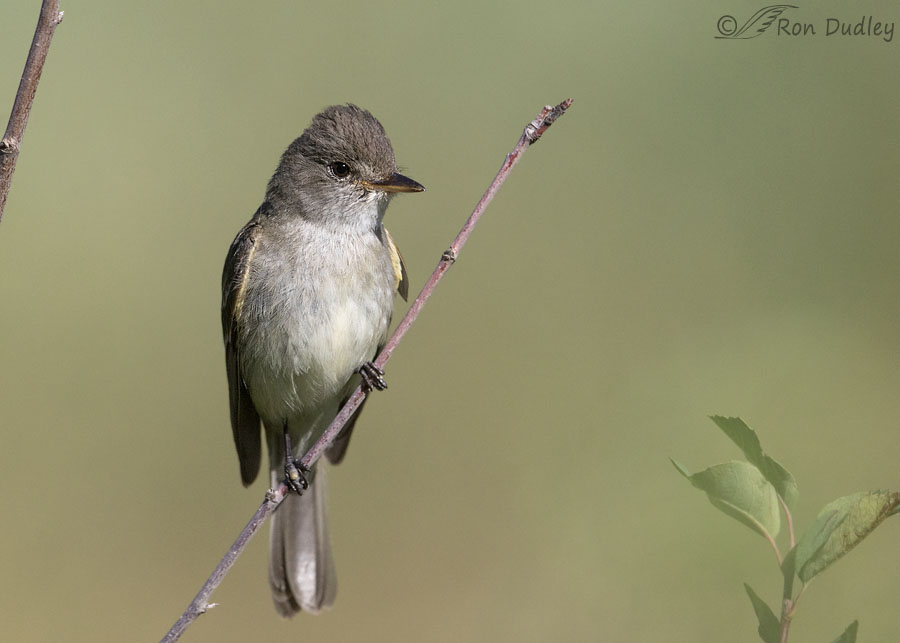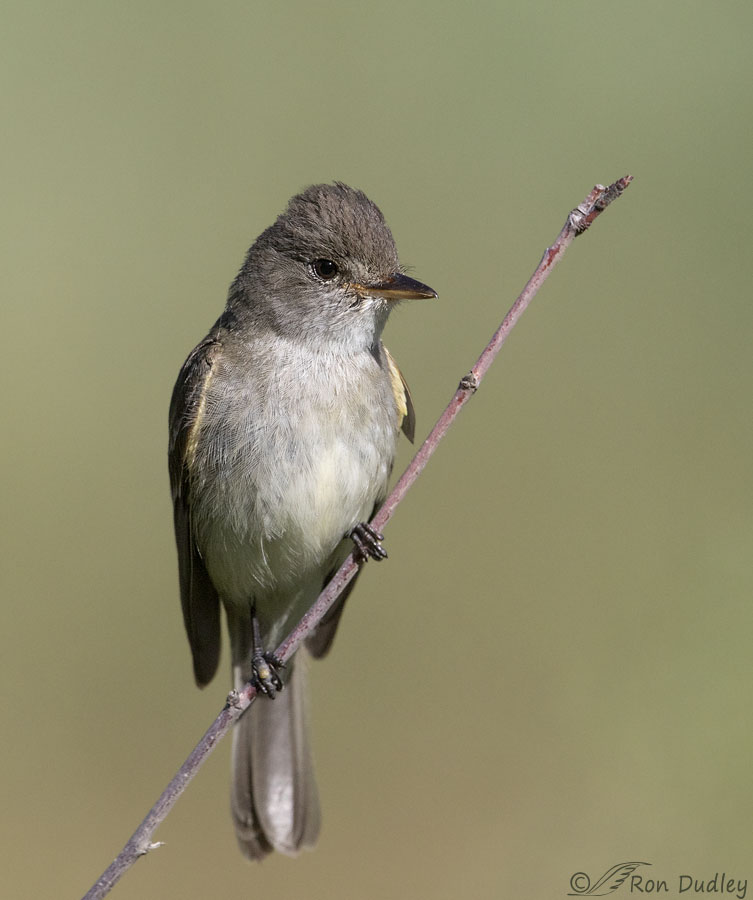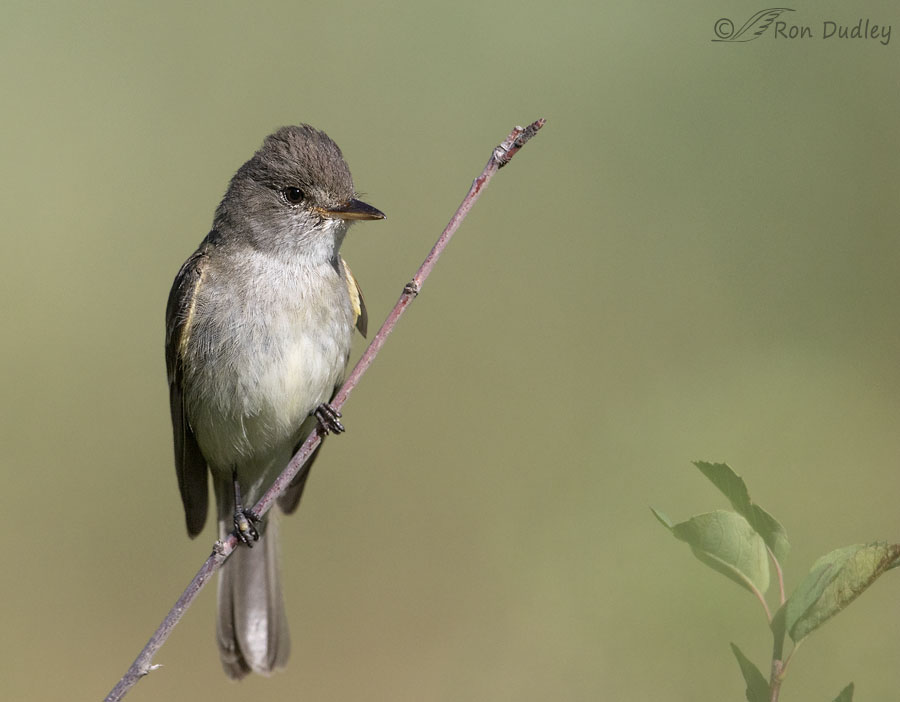A double conundrum, actually – composition and ID.

1/6400, f/6.3, ISO 800, Canon 7D Mark II, Canon EF 500mm f/4L IS II USM + EF 1.4 III Extender, not baited, set up or called in
Yesterday in the mountains this flycatcher came from out of nowhere and landed right in front of me. I didn’t even know it was nearby so its appearance was a serendipitous event on an otherwise very slow morning of shooting. It only stayed for about four seconds but I was able to get a few sharp shots and this is one of them.
It’s most likely a Willow Flycatcher but I don’t know that for sure. The habitat is right for a Willow Flycatcher and I hear them in the area but this one wasn’t making one of its distinctive calls that allows for a positive ID. Empidonax flycatchers can be very difficult to ID without call confirmation so this one will probably remain a mystery.
When I’m processing images like this one for presentation on my blog I often struggle with how to crop them – horizontally or vertically. With the leaves at lower right this horizontal crop gives us at least a hint of pleasing habitat but it includes a twig at upper left that I find slightly annoying. Yes, I could get rid of that twig but I prefer not to.

A vertical crop shows the bird larger in the frame and includes much more detail but I find the image slightly sterile as I often do with BOAS (bird on a stick) images that don’t include at least some habitat.
So I’d be interested to know if my readers have a preference. I’ve asked a similar question about photos in the past but this time I’d like to better explain my motivation for asking.
Readers often respond to that question by saying “it depends on your purpose.” If the image is meant for something like a field guide or an interpretive display or signage for a bird refuge or museum the vertical crop might be preferred for its better detail showing field marks of the species. But if it’s meant simply for aesthetic purposes (prints, etc.) the horizontal crop would often be the preferred choice.
But in this and many other cases my purpose is none of the above, instead it’s for presentation on my blog. Some of my readers prefer detail, some prefer aesthetics and others oscillate back and forth depending on the image.
So once again, I’m asking. What is your preference for this particular image if you have one?
Thanks in advance.
Ron
Addendum: In comments below Wendy and Melanie suggested I crop out the twig in a horizontal presentation. Here’s the result:

For me it works pretty well, although I’ve lost the 5×7 aspect ratio that I usually prefer. So I guess this is a third possible choice..
On a somewhat related note, just before I photographed this flycatcher there were two moose within 40′ of me but they were so deeply buried in the willows I could barely see either one. Talk about frustrating for a nature photographer!


Vertical, just because these little fellows are so hard to I.D. Both are excellent shots.
Wonderful series Ron! As far as crops are concerned, variety is the spice of photographing 😄.
Charlotte
Thanks, Charlotte.
Or for yet another choice, the vertical one but with the left side cropped pretty close to the bird. That way you’ve taken the bird off center, looking to the right side where there is now room to look. Never mind usual ratios of width to height. Imagine it as a Japanese scroll. I can see that.
That’s an interesting idea, Mikal. However, I would argue that the bird isn’t centered as I presented it. There’s significantly more space to the right of the bird than there is to the left.
Personally, I love the cropped photo. Very crisp and clear and really shows the attributes of this bird perfectly.
On another point, this bird looks excellent for a Willow Flycatcher. I really don’t get any other flycatcher type when looking at this other than possibly Alder, and of course Alder doesn’t nest within 500 miles before you took this picture.
Great shot!
Thanks for all the helpful feedback everyone.
By my count of those who expressed a preference so far it’s almost a dead heat – 10 for one of the two horizontal crops and 9 for the vertical. Others had no clearly expressed preference.
It’s no wonder I’ve had a difficult time deciding which one I prefer!
Ron, I love your work. To your question, I was brought up being told keep the foreground/Background as simple as possible so attention is drawn to the subject of the photograph. I get why you hesitate with the vertical crop, but my honest thought is that is the better of the three crops, simply because of how it draws my attention. Of course, you know what they say about opinions…
I don’t much care what they might say about opinions, David. I appreciate yours.
Ron,
I like the first photo because the twig in the upper left-hand corner adds something because it matches the twig the bird is on. I also like the green plant/tree in the lower right-hand corner. I think that the bird looks more natural in this setting as I associate birds with nature.
Thanks Ron
Interesting that you like that twig, Alice. Thanks.
Despite the lack of habitat (which I usually love) the vertical crop and its incredible intimacy appeals most this morning. The other two run a very close second.
Thanks, EC. I’m with you in that my preference for different types can change from image to image.
I like all three–for different reasons…
Thanks, Patty.
I feel a wonderful intimacy with the vertical crop. I hesitate to breath, in anticipation of scaring it away, as though you have frozen time. There is nothing that distracts me from that magical moment.
You said that very well, Sheri. And I wholeheartedly agree about the intimacy that version provides.
I could easily go either way and be equally pleased. But in this case, I’m going to make a slight (very slight) preference for the horizontal for perhaps an odd reason. Flycatchers sit very vertical so most photos I see of them are in a vertical composition. A horizontal presentation is a refreshing change from that usual trend. On the other hand, I do still think the vertical shot you have here is a great presentation. I enjoyed seeing them both.
Good point about them usually perching in a vertical posture, Dan. Of course that observation is spot on.
I like the third also. Lovely lighting and detail. I took a photo of a similar bird yesterday at Silver Lake. I was not sure what it was, another photographer (one using sound to call birds in) said it was a Willow Flycatcher and asked if I wanted him to call it in closer. I said no and tried to keep distance from him. I saw him there on another day and I actually heard the bird calls before I saw him. Calling birds is not my cup of tea, his calls confused me so I can imagine what it does to the birds.
As far as moose I had the scare of my life at Alta Basin photographing wildflowers. I was on the edge of the trail in a stunning meadow of wildflowers on my hands and knees using my macro lens, when a moose walked up on me in the meadow. I thought it was other hikers or joggers, there were a lot of people that morning. Imagine my surprise when I looked up and turned around and saw a moose about 20 feet away looking inquisitively at me. I though I was dead! We looked at each other for a while and she veered to her left and walked on up the hill. I did get a few photos of her but I had my macro on so I had to wait until she would fit in my lens range, by then she was back lit and looks like a moose halo in the dark with bright daisies in the foreground.
Those bird calls really piss me off when I encounter them in the field, April.
Wow, that was an exciting moose encounter! If it had been me I’d probably have “fertilized” those flowers you were photographing…
I prefer the vertical crop because, like you, I find the twig in the upper left to be distracting and the last photo (horizontal with twig cropped)is a good image but the aspect ratio is like a dissonant chord in Stravinsky’s, The Rite of Spring; interesting but uncomfortable. The really great thing about your blog is that it is educational by design so all three images work for your blog. Regarding ID, I have no clue.
“the aspect ratio is like a dissonant chord”
You put it better than I did but I agree, Dennis. Thank you.
I like Wendy & Melanie’s suggestion……… 😉 It is a hard call but don’t care for the “portrait” in this case. At least you “knew” the moose were there and didn’t get a nasty surprise! 🙂 They definitely can be temperamental…..
Judy, it’s amazing how little noise those huge moose made so close to me in the very thick willows. I can see how hikers could get a nasty surprise while hiking in areas like that.
In some of your previous posts where you were able to positively ID the birds as Willow Flycatchers you showed them in willow trees, which I thought added a synergistic element. Not so much the case in the horizontal crop here, so I prefer the vertical crop in which the bird fills up more of the image.
Thanks, Lyle. Some other flycatchers can also be found in willow habitats so in those earlier photos you mentioned I based my ID on their distinctive call. This one was calling but it wasn’t one of the calls that can reliably used for ID.
Much prefer the third image (4×5) Ron. I have no problem with 4×5 under the right circumstances. “Original ratio” ratio has it’s advantages as well and is my preference as well. You can fake people out claiming that it’s a full frame image, if you’re the bragging type. 🙂
Thanks, Frank. Actually that image isn’t exactly 4×5 either. I just played with the ratio until I got rid of the twig and had enough room above the bird’s head. I’d be very surprised if it turned out to be exactly 4×5.
And with my camera at least the native aspect ratio isn’t 5×7. In my settings I can choose between 3×2, 4×3, 16×9 and 1×1 and I believe mine is set at 3:2.
I like number one best. It makes my eyes move around the picture.
Thanks, Arwen.
Sorry, but I’m one of those guys that is in between. I love habitat shots but also like close-ups. My preference here is the vertical shot. Probably because these flycatchers are so tough, I can study and compare with the vertical. I have to admit, although I like/love habitat shots, habitats do distracts me. Hey, I’m a naturalist and find all nature fascinating.
Great post, thanks for sharing.
“In between” happens, Dick – nothing wrong with that. And it still helps me to know how my readers feel about different presentations.
“Stick” is habitat, amiright? 😎 I like the vertical crop for the detail it offers of the bird aaaand I like the way the two twigs frame the bird while the greenery gives him something to look at. Plus, for some reason, his tail doesn’t appear quite as soft in #1; not sure why that is. Yep, I’m part of the no-help club.
BTW, yesterday’s thistle talk inspired me — had an artichoke for dinner. 😋
Yup, stick is habitat. But in that case I guess the bird is “on habitat” rather than “in habitat”… 🙂
Thanks for the chuckle from your last sentence, Marty.
vertical
Thanks.
So I played with your photo just a touch and did a sliding proportional crop from the top left corner to remove the twig to the left. I found the result quite pleasing with the flycatcher left of center and the leaves in the right corner. (I wanted to share my result but can’t figure out how to post it) For me, a natural setting with foliage is the most pleasing. The vertical crop works for field identification. In conclusion, I love all three options and am always in awe of your ability to capture the essence of your subject.
Melanie. when I tried what you describe and if I understand you correctly I thought the bird ended up too close to the left edge of the frame. But it sounds like both you and Wendy (below) have the same preference so I may be in the minority. Thank you.
Personally I love the third option. I am flattered that you tried it and posted it. Thank you!
Not going to help you out very much Ron because I like them both. I think I always prefer horizontal,and I would bet you do as well, but especially for posting on the blog I think it is good to present both. Both photos are sharp with good catch eye etc. The vertical of course brings everything in closer for those who want to see more detail.
“Not going to help you out very much Ron because I like them both”
That feedback still helps, Everett. Thanks.
I have a hard time with identifying the Willow and Alder Flycatcher, as around here many times the preferred habitat is inter-mingled…willows and alder often growing together in wet areas. I know the voice should decide but it’s still hard. Then throw in the Eastern Phoebes and Wood Pewees and then I say ‘Wow’ like that bird and try the ID when I get to my computer. 😀 Most times I prefer a vertical crop but for birds in flight I like the horizontal…it seems to fit the occasion better. Most times vertical gives me the look I’m after…more detail of the bird with some background but then it works with my lens better…I only have 100/400 so I’m limited as to my shots. For good detail I have to be fairly close. Your lens give us the good detail that also gives good background. Don’t know if that makes sense…
It makes perfect sense, Kathy.
The combination of my lens and the fact that I was close to the bird gave me plenty of detail for both types of presentations. If I didn’t have oodles of detail for the vertical crop I wouldn’t even consider it.
And yes, accurate ID for all of those birds is hard. I’m not strong on ID anyway so without help from others I’d often be forced to make stabs in the dark…
I like the horizontal presentation best. I really like the few leaves in the lower right, balanced by the rascally twig top left.
I like the vertical shot as well, just not as much and its always nice to get closer.
I enjoy seeing both images along with your always entertaining and engaging descriptions.
Having both is a nice one-two punch that satisfies.
Thanks for that feedback and explanation, Dave. You explained yourself well.
Hello,
I think the landscape view would look lovely if you cropped out the stick in the top left. I like the leaves in the bottom for balance andinterest and the bird on the stick is lovely against the plain background.
Wendy, the problem for me with “cropping” out that twig is that it would put the bird a little too close to the left edge of the frame, for my tastes at least. I tried doing exactly that but the result seemed a little unbalanced to me (rule of thirds and all that).
But then maybe that’s just me. Perhaps others would prefer your solution so I appreciate you offering it.
I prefer the vertical, but it depends on situation.
Thanks, Eddie.